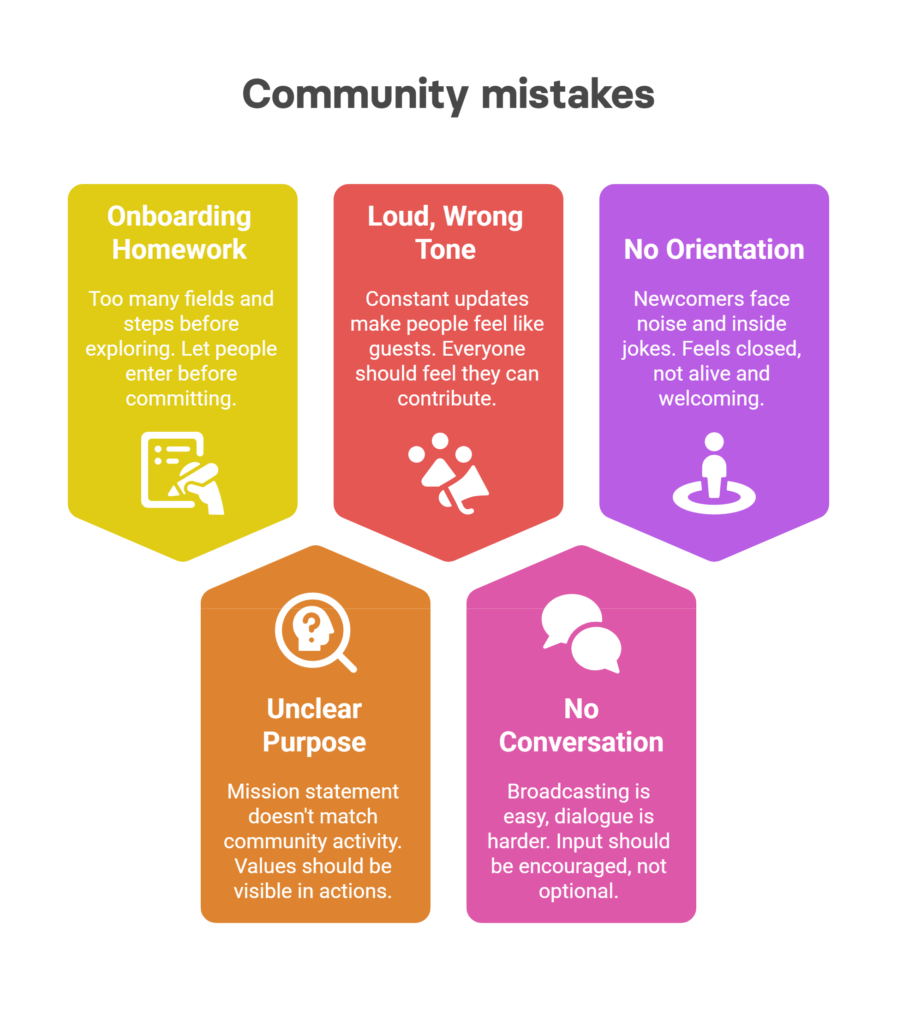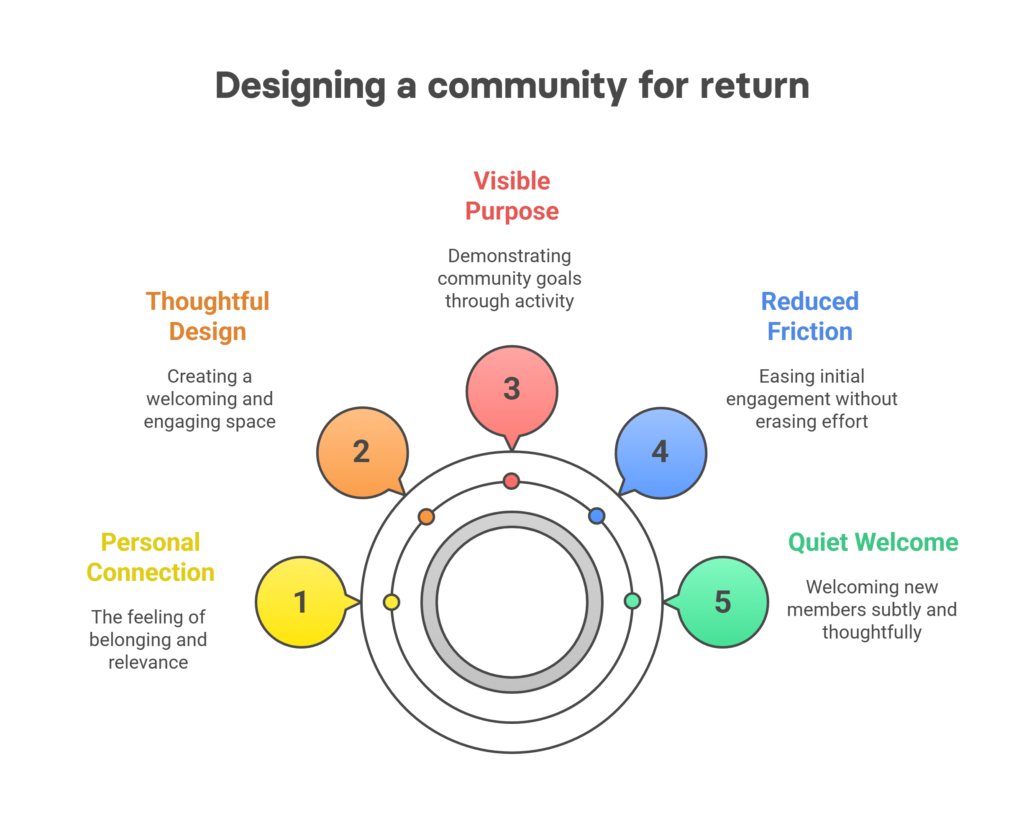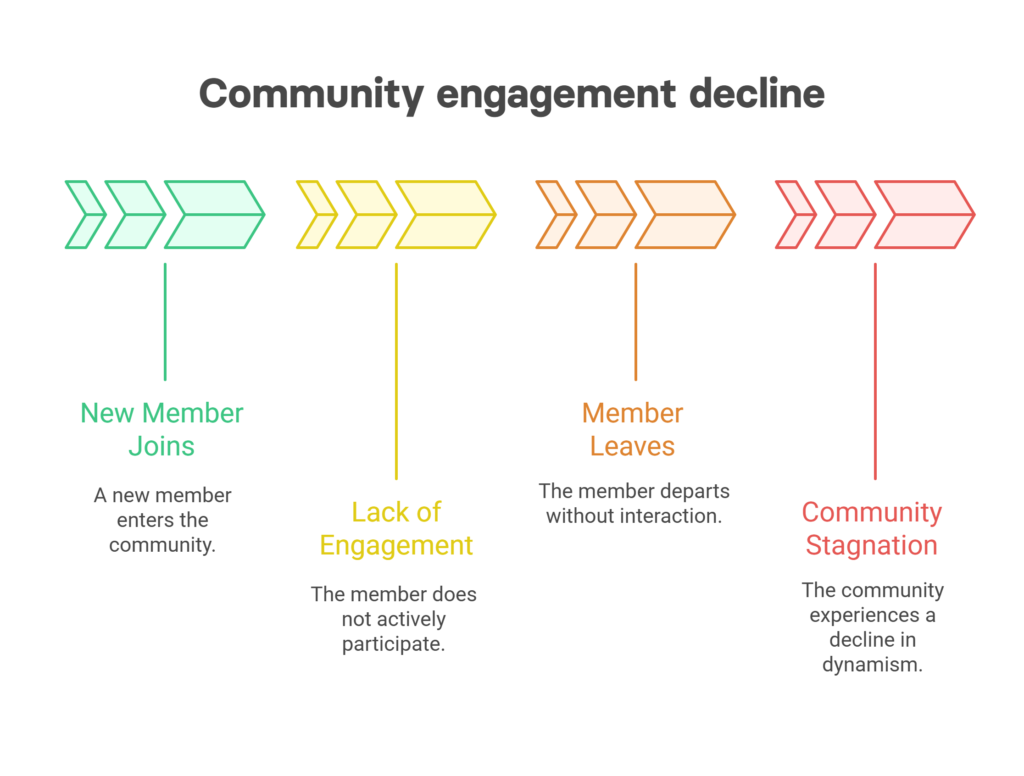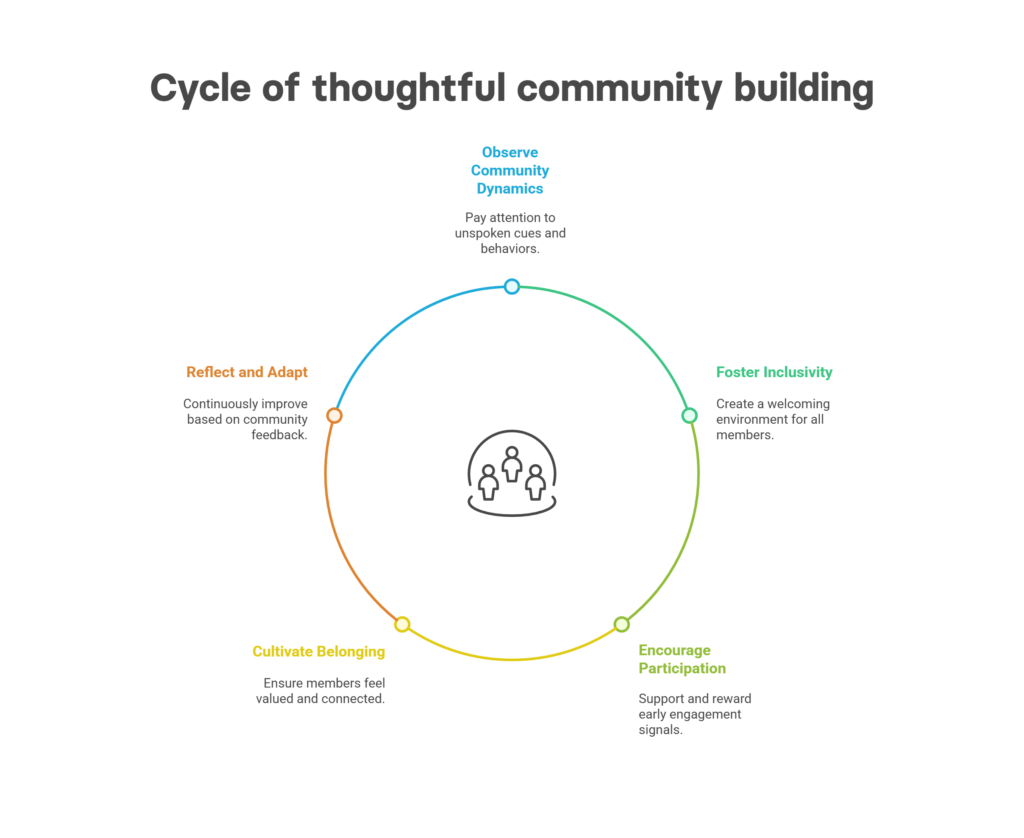There’s a moment at the beginning of someone’s time in a community that often gets overlooked. It’s not the sign-up. It’s not the welcome message. It’s what happens after that; when the person first starts looking around, trying to get a feel for the place.
This moment is quiet. No one announces it. There’s no alert for it on your dashboard. But it’s where the decision gets made.
They’re deciding whether to come back.
Sometimes they don’t even know they’re making that call. They’re just moving through a space, noticing what’s there, how it feels, how it moves. And in that process, they start forming a story about whether they fit, whether the space makes sense, whether it’s worth another visit. Whether it asks too much of them too soon. Or nothing at all.
Most people won’t give you much time. That’s not because they’re impatient or disloyal. It’s just that there are too many things competing for their attention. Three or four visits. That’s the window. That’s all you get to show that the space they’ve just entered is one they might want to return to.
And yet, so much of what we call “community strategy” kicks in after that moment has already passed. We obsess over engagement metrics, content calendars, ambassador programs but we miss the fundamentals. We miss the fact that most of our community members never make it far enough to be measured at all.
They don’t rage quit. They don’t tell you what went wrong. They just drift. And by the time you notice, the chance to do something about it has already gone.
That’s what this article is about. Not churn in the classic sense. Not retention campaigns or loyalty mechanics. Just the first few steps. The early texture of belonging or the absence of it. The tone that gets set before anyone even says a word.
Because when someone walks into a room, they’re not waiting for instructions. They’re already forming impressions. About whether they’re welcome. Whether they’re expected. Whether this place is for people like them or people like someone else.
And the answers to those questions are already there. Whether you meant to put them there or not.
What really happens in the first few visits
When someone joins a community, they’re not thinking about retention. They’re not asking whether the platform has enough active users or whether the content cadence is optimal. What they’re looking for, often without realising it, is a signal. Something that tells them what kind of space this is and whether it was designed with people like them in mind.
That signal doesn’t come from a splashy welcome message or a polished onboarding flow. It comes from what’s visible. What’s alive. What feels like it has a rhythm.
And more than anything, it comes from what feels human.

If their first interaction feels mechanical, like an automated DM, a generic thread with no replies, a wall of updates that read like company announcements, they’re not going to push through and look for more. They’re going to move on. Because that early experience didn’t give them a reason to believe anything deeper was waiting.
This isn’t about short attention spans or content fatigue. It’s about trust. And trust, in this context, is built less on what you say and more on what you show; about what kind of relationships this community values, how effort is acknowledged, whether there’s a pulse behind the interface.
In those first few visits, people are asking questions like:
- Is anyone actually here?
- Will someone notice if I speak?
- Do I have to act a certain way to belong?
- Does this place already have a shape and do I fit inside it?
They’re not asking these questions directly. But they’re watching for answers. And those answers show up in things most teams overlook: the tone of replies, the pace of conversation, whether introductions go unanswered, whether newcomers get the same attention as regulars.
Every small detail sends a message.
Most communities lose members early not because they lack value, but because that value is too far from the surface. It’s buried under noise. Or formality. Or assumptions about what people will figure out if they just stick around.
But most people won’t. They’ll give it a few tries and then they’ll make a decision. Not necessarily the right one. Just the available one.
And that decision sticks.
Because once someone decides a space isn’t for them, it’s rare that they come back just to see if they were wrong.
Where most communities go wrong
It’s not that people don’t care about first impressions. It’s that they care about the wrong ones.
Too many community teams focus on surface polish. Branding. Layout. Welcome flows. The logic is sound: if we make it look intentional, people will trust it. If we look prepared, people will stay.
But trust rarely works that way.
People don’t leave because the onboarding message was one sentence too short. They leave because they couldn’t figure out what the space was for. Or who it was for. Or whether anyone would notice if they said something.
And most of the time, the things that push people away don’t even feel like decisions. They’re just defaults.
Here are a few we’ve seen, again and again.

The onboarding feels like homework
Too many fields. Too many steps. Too many explanations before someone’s had a chance to look around. People aren’t looking for a tutorial. They’re trying to get a feel for the room. Let them enter before you ask them to commit.
The purpose isn’t clear enough to feel real
You can write a mission statement. You can say what the community is “about.” But if the activity inside doesn’t reflect that purpose, people won’t believe it. A community’s values are visible in what people actually do, not what the homepage says.
The content is loud, but the tone is off
When everything is an update, a win, an announcement; people start to feel like guests in someone else’s story. And if they don’t see where their voice fits, they won’t test it out. Not everyone needs to post. But everyone needs to feel like they could.
There’s communication, but no conversation
Broadcasting is easy. Dialogue is harder. If every post is one-way, people learn that their input is optional. Or worse, unwanted. And once that expectation sets in, it’s difficult to reverse.
There’s energy, but no orientation
In fast-moving communities, newcomers often walk into a wall of noise. Inside jokes. Half-finished threads. Rapid responses between people who already know each other. That doesn’t make the community feel alive. It makes it feel closed.
None of these patterns are malicious. Most come from a good place, from a desire to show up strong, to signal momentum, to demonstrate value early.
But good intentions don’t change the fact that first impressions aren’t made at the design level. They’re made at the level of human instinct. People stay because something feels familiar or at least, understandable.
And most communities lose people because they haven’t made the right things obvious soon enough.
How to design a community people want to return to
If you want people to return, you have to think about what makes something worth returning to. It’s not volume. It’s not activity. It’s not even the promise of value, at least not right away. It’s something quieter.
It’s the sense that there’s a shape to the space. That someone has thought about the experience of arriving not just the metrics of staying. That the pace isn’t overwhelming. That attention isn’t demanded, but welcomed.
The truth is, most people don’t enter a new community ready to contribute. They’re not looking for a spotlight. They’re just trying to figure out if they belong. And most of what tells them that doesn’t come from what you say. It comes from what’s already happening in the space. What people respond to. What gets ignored. What kinds of behaviour are visible and what kinds aren’t.
Designing for return means designing for that in-between space. The space where someone’s not fully in, but not fully gone either.
So what helps?

Give people room to look around before asking for anything
Not everyone wants to introduce themselves right away. Not everyone knows what to post. Don’t mistake silence for disinterest. Sometimes people are just watching. The question is; what are they seeing?
Make purpose visible through activity, not just messaging
A banner that says “Welcome to a space for deep conversation” means nothing if the top post is a poll about brand preferences. Let the first few scrolls tell the real story. If they don’t, fix what shows up there, not the headline.
Reduce friction, but don’t erase effort
It’s good to make things easy. But too much automation can make a space feel empty. Let people do small things that signal intent: bookmarking a post, reacting to something, following a topic. These are signs of life. They matter.
Don’t overfill the room
Flooding the feed with every possible update, article or feature doesn’t show that the community is alive. It shows that it’s crowded. Curation matters more than coverage. Let people find a rhythm before you raise the volume.
Start soft and show you are listening
You don’t need a big welcome thread if no one replies to it. It’s better to have one thoughtful response to a first post than ten generic greetings. People notice where attention goes. Make sure it lands on new voices.
Above all, remember that people don’t return because they’re told to. They return because something small worked. Something made sense. Something felt like it was there for them, not for a cohort, not for a segment, but for them as a person.
That feeling can’t be forced. But it can be designed for. And it starts with noticing what the space looks like to someone seeing it for the first time.
The cost of getting it wrong

When someone leaves your community early, you usually don’t notice.
They haven’t posted. They haven’t replied. Maybe they didn’t even introduce themselves. There’s nothing obvious to point to. No alert, no feedback, no data spike. Just one less person quietly looking around.
That’s the problem.
Because when someone leaves at that stage, it’s not a verdict on your content or your roadmap or your features. It’s not about what you’ve built. It’s about what they felt, or didn’t, when they showed up. The welcome they didn’t feel. The silence they weren’t sure how to respond to. The space that looked like it was already running without them.
And once they go, that moment’s gone with them.
They don’t come back a month later to check if anything’s changed. They don’t circle back to see if maybe they missed something. They move on. And they carry an idea of your community with them, maybe even talk about it. Not maliciously. Just casually, when someone asks. “Yeah, I checked it out. Didn’t feel like much was happening.”
That kind of loss doesn’t show up on your dashboard. But it builds.
You start to see the same few people doing most of the talking. You start to wonder why newer members don’t get involved. You work harder to create engagement, but it feels like you’re doing it for a smaller group each time. The space starts to settle into itself. Less dynamic. Less surprising. Still working, maybe, but not growing in the way it should.
And by then, the moment that could’ve changed it already passed.
The hard part is, none of this looks urgent. There’s no crisis. Just a slow drift away from what the space could’ve been if more people had stayed long enough to shape it.
That’s the cost. Not churn in the traditional sense. But a kind of cultural narrowing. A quiet loss of momentum that only becomes clear once it’s hard to reverse.
What thoughtful community builders do differently

There’s no universal path to getting this right.
Communities emerge in different ways. Some are deliberate, some accidental. Some gather fast and loud, others take years to take shape. But underneath the variety, you start to notice a pattern, especially when you’ve seen enough of them from the inside.
The ones that last, the ones people come back to even after drifting, weren’t always the biggest. They weren’t always the most active. But they were built with care.
Not just energy. Not hustle or output. Actual care. The kind that notices the things most people overlook.
They paid attention to who never said anything. To the person who came once, said hello, then never returned. To the thread that went unanswered. To the stretch of silence that didn’t feel like calm, but like absence.
And they didn’t always wait for data to prove what they already sensed. They moved when something felt off. They listened before they measured. They made room for things that didn’t show up in charts.
Because most of what shapes a community happens in the spaces between activity. It’s in the hesitations. The quiet decisions. The stories people start to tell themselves about what kind of place this is.
That’s where thoughtful builders do their real work. They don’t assume participation is a given. They understand it’s fragile. That it has to be earned, one small gesture at a time. Not with gamified nudges or loud incentives but with presence. With consistency. With moments that show someone they’re welcome even before they contribute.
They design for people who might not speak right away. They make the space understandable even if you just read silently. They give people time to acclimate. They treat lurking as legitimate. Because watching is a kind of engagement too. And if the space feels safe enough, some of those watchers eventually become contributors.
Not all. But enough.
They reward early signals, even when they’re small. A reaction. A short reply. A login after a long break. They build systems that notice those moments. And when someone does speak, they make sure it doesn’t go into a void.
They know belonging starts earlier than most teams realise. And that contribution rarely shows up without it.
That’s what changes everything. Not the strategy. Not the stack. Just the mindset. The shift from “How do we drive engagement?” to “What kind of place are we making here and what does it take for someone to feel at home in it?”
The best community builders don’t chase activity. They cultivate environments that make participation feel possible. Natural. Sometimes even inevitable.
Not because they pushed harder but because they understood that in the early days, what someone feels matters more than what they do.
And they built for that.
What your first impression is really saying
You don’t get to be in the room when someone decides how they feel about your community. By the time you look at their profile or notice their absence, the moment has already passed. The impression is already made.
Not by the copy you wrote or the onboarding flow you shipped. But by what they saw when they arrived. What was visible. What wasn’t. How the place carried itself.
That’s the message. And every space has one.
It might say: “We’re glad you’re here.”
It might say: “Catch up, we’ve already started.”
It might not say anything at all. Which is a message too.
People don’t walk in looking for a mission statement. They just look around and start building a sense of what this place is and whether they belong inside it. Whether it’s designed to include them or just tolerate them. Whether it needs them or already has enough.
That first scroll, that first silence, that first unanswered post, those are the moments where meaning forms. Not because anyone planned it that way, but because meaning always forms.
Communities aren’t neutral. They carry a tone, even when no one’s talking. They give off signals, even when nothing is happening. The rhythm, the density, the feel of the place, it either opens a door or leaves it slightly shut.
And once someone decides how to interpret that feeling, it’s hard to undo. That’s the real weight of a first impression. It doesn’t arrive when you send the welcome message. It’s already halfway formed by the time they open it.
So the question isn’t: “Did we make them feel welcome?”
The question is: “What might they have already decided before we ever said a word?”
Because whether or not you meant to say anything…you already did.







